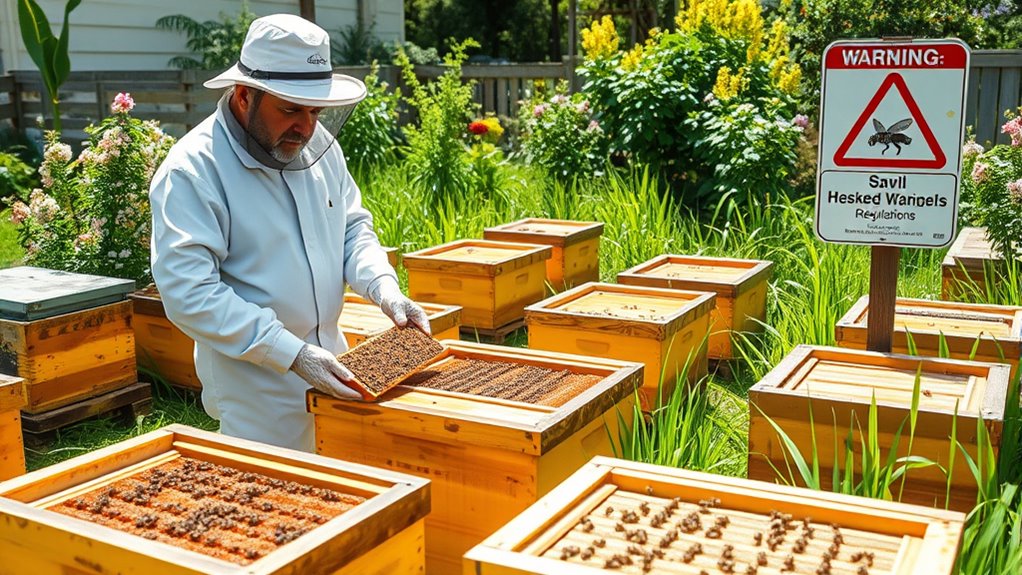Getting into backyard beekeeping can seem straightforward, but overlooking local laws might lead to unnecessary complications. Many communities have specific regulations about hive placement, quantity, and permits that can catch newcomers off guard. Ignoring these rules could mean fines, hive removal, or worse, legal trouble. Staying informed about your area’s beekeeping laws is essential for a smooth start and healthy hive. Curious about how to navigate these regulations effectively?
Key Takeaways
- Research and adhere to local beekeeping ordinances to ensure legal hive placement and avoid fines.
- Obtain necessary permits or registrations before starting your backyard beekeeping.
- Maintain proper hive distance from neighbors, sidewalks, and streets to prevent safety issues.
- Conduct regular hive inspections to prevent disease, pests, and hive health problems.
- Engage with local beekeeping clubs or extension offices for guidance and community support.

Are you considering starting a backyard hive? If so, it’s essential to understand the laws that govern beekeeping in your area to avoid costly mistakes. Local regulations often specify how many hives you can keep, where you can place them, and how to manage your honey bee habitat responsibly. Before you begin, take the time to research your city, county, or state’s beekeeping ordinances. Some places require permits or registration, and failing to comply can lead to fines, forced hive removal, or other legal issues. Knowing the rules upfront helps you plan accordingly and guarantees your beekeeping journey starts on the right foot.
One of the most important aspects of backyard beekeeping is maintaining a healthy hive, which involves regular hive maintenance. This means routinely inspecting your hives to monitor for signs of disease, pests, or other issues that could threaten your honey bees’ health. Proper hive maintenance isn’t just about preventing problems; it’s also about fostering a thriving honey bee habitat. You’ll need to check for enough space inside the hive, ensure the queen is laying eggs, and keep the hive free of debris and pests like Varroa mites. By staying vigilant and proactive, you create a safe environment that supports the bees’ natural behaviors and helps them produce honey efficiently. Additionally, understanding beekeeping best practices ensures you adopt effective management techniques that promote hive strength and productivity.
Understanding the legal requirements also includes knowing restrictions on hive placement. Many areas require hives to be at a certain distance from neighboring properties, sidewalks, or streets to prevent conflicts with neighbors and ensure safety. Placement considerations also involve protecting your bees from harsh weather and predators while minimizing disturbance to your community. When setting up your hive, use fencing or screens if necessary, and position the hive in a shaded area to help regulate temperature during hot months. These steps not only align with legal standards but also improve your hive’s overall health and productivity.
Finally, staying informed about your local beekeeping laws means you’re better equipped to handle inspections, renew permits, or participate in community programs. Engage with local beekeeping clubs or extension offices; they often provide resources, workshops, and updates on legislation changes. Being proactive in understanding and following these laws helps you avoid fines or legal battles, and it demonstrates responsible beekeeping that respects your neighbors and the environment. Starting a backyard hive can be rewarding, but only when you comply with local regulations and commit to proper hive maintenance. This approach ensures your honey bee habitat remains healthy, productive, and in harmony with your community.
Conclusion
By following local beekeeping laws, you’ll avoid fines and keep your hive healthy. Did you know that over 30% of backyard beekeepers report legal issues as their biggest challenge? Staying informed about regulations not only protects your investment but also helps you enjoy the sweet rewards of honey and pollination. Keep learning, comply with rules, and you’ll enjoy a thriving, legal hive that benefits both you and your community.
Hi, I’m Emma. I’m the Editor in Chief of Tiny House 43, a blog all about tiny houses. While tree houses are often associated with childhood, they can be the perfect adult retreat. They offer a cozy space to relax and unwind, surrounded by nature. And since they’re typically built on stilts or raised platforms, they offer stunning views that traditional homes simply can’t match. If you’re looking for a unique and romantic getaway, a tree house tiny house might just be the perfect option.









